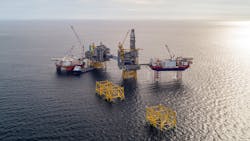The start-up of Johan Sverdrup oil field in the Norwegian North Sea has been approved by the Norwegian Petroleum Directorate.
Equinor plans start up this fall for Phase 1 development. Construction Phase 2 is expected to start in fourth-quarter 2022. The field is expected to produce oil for the next 40 years.
Johan Sverdrup—the third largest oil field on the Norwegian shelf by reserves—lies on Blocks 16/2, 16/3, 16/5, and 16/6, 155 km west of Karmoy and 40 km south of Grane field. The field was proven by Lundin in 2010 through well 16/2-6 (Avaldsnes).
According to Equinor, investment costs for development of the first stage of construction are expected to be 83 billion kroner.
Total recoverable reserves are estimated at 2.7 billion boe (95% oil, 3% dry gas, the remainder NGL). The field has a production capacity of 660,000 b/d.
The Johan Sverdrup development is being implemented in two construction stages. The first includes a field center with four installations (living quarters platform with auxiliary systems, a process platform, a drilling platform, and a riser platform) connected by bridges.
Pipelines for transporting oil and gas, the power from shore unit, and three subsea templates for water injection are linked to the riser platform.
The second stage consists of an expansion of the field center with a new process platform, five subsea templates connected to the field center, and development of the outer areas of the reservoir (OGJ Online, May 15, 2019).
Further development of central areas also is planned through additional wells from the drilling platform.
Electric power for normal operation of Johan Sverdrup field will be supplied from the land-based grid. Operation of the area solution for power from shore is defined in the plan for installation and operation.
Gas and stabilized oil will be transported through a gas pipeline to Statpipe and an oil pipeline to Mongstad, north of Bergen.
